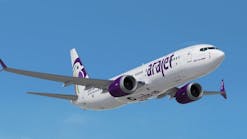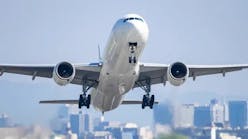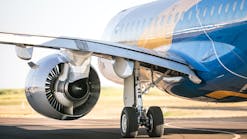SAVANNAH, GA – Gulfstream Aerospace Corp., a wholly owned subsidiary of General Dynamics, has successfully demonstrated aircraft control using “Fly-By-Wireless” technology. This historic flight, which took place on Sept. 18, is the first known application of wireless signaling for a primary flight-control surface in a civilian or military aircraft.
During a two-hour flight over Savannah, four distinct signal types transferred input from the pilot to the lateral controls on the Gulfstream GV test aircraft. A mechanical system controlled the ailerons; a Fly-By-Wire system manipulated the outboard spoilers; the Fly-By-Wireless system handled the mid-spoilers; and a fiber-optic Fly-By-Light system moved the inboard spoilers.
All four systems worked simultaneously during the flight. This allowed Gulfstream to compare the performance of the Fly-By-Wireless system to that offered by the three other control systems. Pilots noted consistent handling characteristics regardless of the actuation-control technology.
“After developing the Fly-By-Wire system, the next goal for Gulfstream was to reduce the complexity and weight of that system without sacrificing safety or reliability,” says Pres Henne, senior vice president, Programs, Engineering and Test, Gulfstream. “This Fly-By-Wireless flight proved we achieved that goal. There was no difference in signal quality or strength among Fly-By-Wireless, Fly-By-Light or Fly-By-Wire. That benefit, combined with the streamlined profile of Fly-By-Wireless, makes it a potential backup for other flight-control systems.”
The Fly-By-Wireless control system was developed by Gulfstream and Invocon, a system engineering firm near Houston. It offers an additional channel of communication for redundancy, which increases system safety. Gulfstream is reviewing the benefits of wireless technology for applications beyond backup flight control.
This is the second time in 2008 that the business-jet manufacturer has successfully tested a new way of delivering input from the pilot to a flight-control surface. In March, Gulfstream tested a fiber-optic Fly-By-Light system during a 75-minute flight over Savannah.




